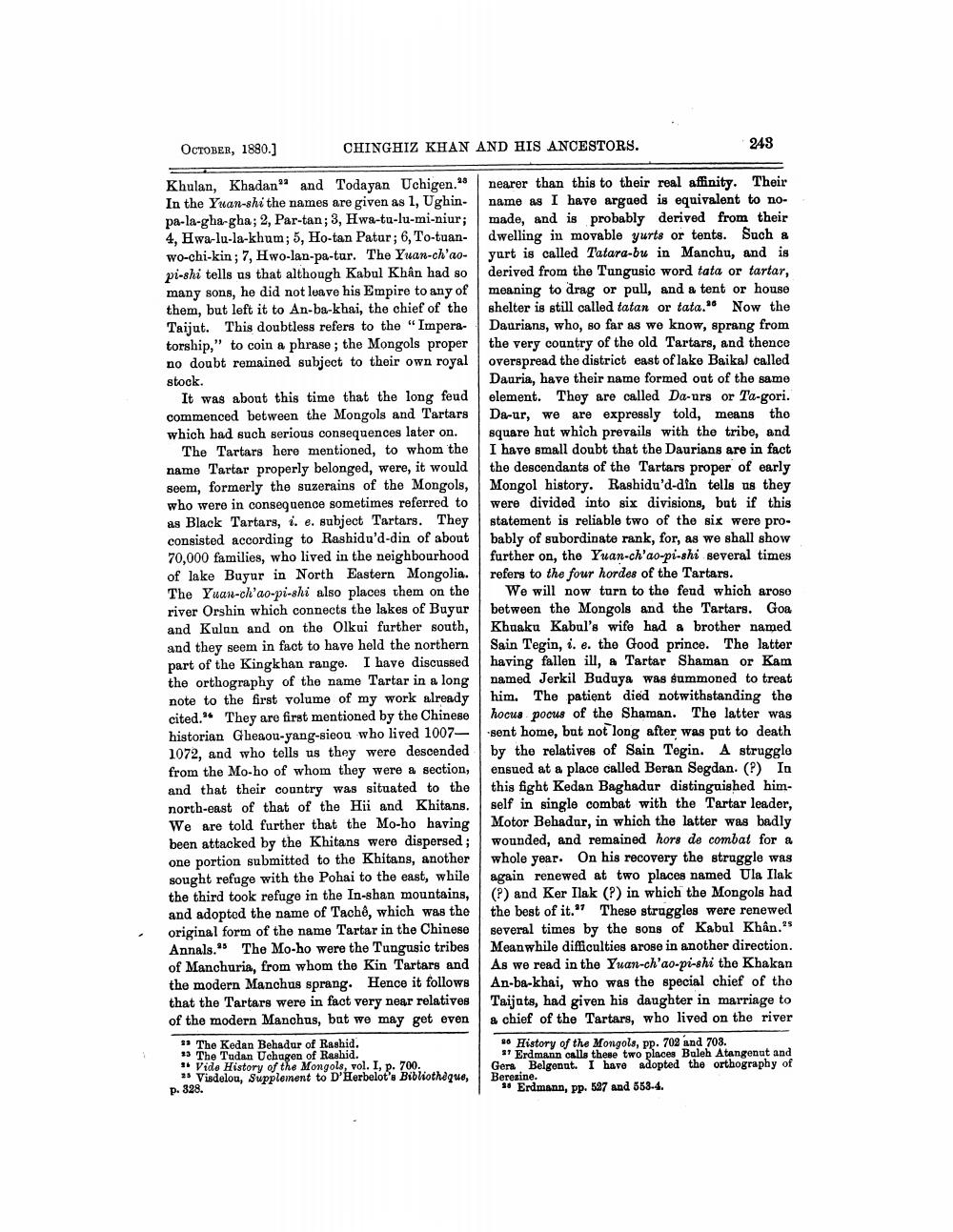________________
OCTOBER, 1880.]
CHINGHIZ KHAN AND HIS ANCESTORS.
243
Khulan, Khadan" and Todayan Uchigen.28 In the Yuan-shi the names are given as 1, Ughinpa-la-gha-gha; 2, Par-tan; 3, Hwa-tu-lu-mi-niur; 4, Hwa-lu-la-khum; 5, Ho-tan Patur; 6, To-tuanwo-chi-kin; 7, Hwo-lan-pa-tur. The Yuan-ch'aopi-shi tells us that although Kabul Khân had so many sons, he did not leave his Empire to any of them, but left it to An-ba-khai, the chief of the Taijut. This doubtless refers to the "Imperatorship," to coin a phrase ; the Mongols proper no doubt remained subject to their own royal stock.
It was about this time that the long feud commenced between the Mongols and Tartars which had such serious consequences later on.
The Tartars here mentioned, to whom the name Tartar properly belonged, were, it would seem, formerly the suzerains of the Mongols, who were in consequence sometimes referred to as Black Tartars, i. e. subject Tartars. They consisted according to Rashidu'd-din of about 70,000 families, who lived in the neighbourhood of lake Buyur in North Eastern Mongolia. The Yuan-ch'ao-pi-shi also places them on the river Orshin which connects the lakes of Buyur and Kulon and on the Olkui further south, and they seem in fact to have held the northern part of the Kingkhan range. I have discussed the orthography of the name Tartar in a long note to the first volume of my work already cited." They are first mentioned by the Chinese historian Gheaou-yang-sieou who lived 1007— 1072, and who tells us they were descended from the Mo-ho of whom they were a section, and that their country was situated to the north-east of that of the Hii and Khitans. We are told further that the Mo-ho having been attacked by the Khitans were dispersed; one portion submitted to the Khitans, another sought refuge with the Pohai to the east, while the third took refuge in the In-shan mountains, and adopted the name of Tachê, which was the original form of the name Tartar in the Chinese Annals. The Mo-ho were the Tungusic tribes of Manchuria, from whom the Kin Tartars and the modern Manchus sprang. Hence it follows that the Tartars were in fact very near relatives of the modern Manchus, but we may get even
11 The Kedan Behadur of Rashid. 15 The Tudan Uchagen of Rashid. 1. Vide History of the Mongols, vol. I, p. 700.
25 Visdelou, Supplement to D'Herbelot's Bibliothèque, p. 328.
nearer than this to their real affinity. Their name as I have argaed is equivalent to nomade, and is probably derived from their dwelling in movable yurts or tents. Such a yurt is called Tatara-bu in Manchu, and is derived from the Tungusic word tata or tartar, meaning to drag or pull, and a tent or house shelter is still called tatan or tata." Now the Daurians, who, so far as we know, sprang from the very country of the old Tartars, and thence overspread the district east of lake Baika) called Dauria, have their name formed out of the same element. They are called Da-urs or Ta-gori. Da-ur, we are expressly told, means tho square hut which prevails with the tribe, and I have small doubt that the Daurians are in fact the descendants of the Tartars proper of early Mongol history. Rashidu'd-din tells us they were divided into six divisions, but if this statement is reliable two of the six were probably of subordinate rank, for, as we shall show further on, the Yuan-ch'ao-pi-shi several times refers to the four hordes of the Tartars.
We will now turn to the fend which aroso between the Mongols and the Tartars. Goa Khuaku Kabul's wife had a brother named Sain Tegin, i.e. the Good prince. The latter having fallen ill, a Tartar Shaman or Kam named Jerkil Buduya was summoned to treat him. The patient died notwithstanding the hocus pocus of the Shaman. The latter was sent home, but not long after was put to death by the relatives of Sain Tegin. A struggle ensued at a place called Beran Segdan. (P) In this fight Kedan Baghadur distinguished himself in single combat with the Tartar leader, Motor Behadur, in which the latter was badly wounded, and remained hors de combat for a whole year. On his recovery the struggle was again renewed at two places named Ula Ilak (?) and Ker Ilak (?) in which the Mongols had the best of it." These struggles were renewed several times by the sons of Kabul Khân." Meanwhile difficulties arose in another direction. As we read in the Yuan-ch'ao-pi-shi the Khakan An-ba-khai, who was the special chief of tho Taijuts, had given his daughter in marriage to a chief of the Tartars, who lived on the river * History of the Mongols, pp. 702 and 703.
* Erdmann calls these two places Buleh Atangenut and Gera Belgonut. I have adopted the orthography of Berezine. 91 Erdmann, pp. 527 and 553-4.




